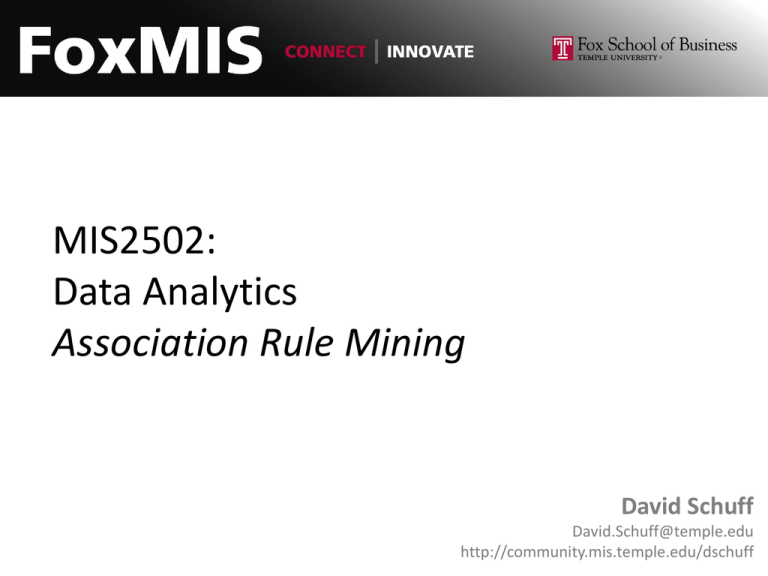Association Rule Mining
advertisement

MIS2502:
Data Analytics
Association Rule Mining
David Schuff
David.Schuff@temple.edu
http://community.mis.temple.edu/dschuff
Association Rule Mining
Find out which items
predict the occurrence of
other items
Also known as “affinity
analysis” or “market
basket” analysis
Uses
• What products are bought together?
• Amazon’s recommendation engine
• Telephone calling patterns
Examples of Association Rule Mining
• Market basket analysis/affinity analysis
– What products are bought together?
– Where to place items on grocery store shelves?
• Amazon’s recommendation engine
– “People who bought this product also
bought…”
• Telephone calling patterns
– Who do a set of people tend to call most often?
• Social network analysis
– Determine who you “may know”
Market-Basket Transactions
Basket
1
2
3
Items
Bread, Milk
Bread, Diapers, Beer, Eggs
Milk, Diapers, Beer, Coke
4
5
Bread, Milk, Diapers, Beer
Bread, Milk, Diapers, Coke
Association Rules
from these
transactions
XY
(antecedent consequent)
{Diapers} {Beer},
{Milk, Bread} {Diapers}
{Beer, Bread} {Milk},
{Bread} {Milk, Diapers}
Core idea: The itemset
Itemset
A group of items of interest
{Milk, Beer, Diapers}
Basket
Association rules express
relationships between itemsets
XY
{Milk, Diapers} {Beer}
“when you have milk and diapers,
you also have beer”
Items
1
Bread, Milk
2
Bread, Diapers, Beer, Eggs
3
Milk, Diapers, Beer, Coke
4
Bread, Milk, Diapers, Beer
5
Bread, Milk, Diapers, Coke
Support
• Support count ()
– In how many baskets does the itemset
appear?
– {Milk, Beer, Diapers} = 2
(i.e., in baskets 3 and 4)
• Support (s)
– Fraction of transactions that contain all
items in X Y
– s({Milk, Diapers, Beer}) = 2/5 = 0.4
X
Basket
Items
1
Bread, Milk
2
Bread, Diapers, Beer, Eggs
3
Milk, Diapers, Beer, Coke
4
Bread, Milk, Diapers, Beer
5
Bread, Milk, Diapers, Coke
2 baskets have milk,
beer, and diapers
Y
• You can calculate support for both X and Y
separately
– Support for X = 3/5 = 0.6
– Support for Y = 3/5 = 0.6
5 baskets total
Confidence
• Confidence is the strength
of the association
– Measures how often items in
Y appear in transactions that
contain X
c
Basket
Items
1
Bread, Milk
2
Bread, Diapers, Beer, Eggs
3
Milk, Diapers, Beer, Coke
4
Bread, Milk, Diapers, Beer
5
Bread, Milk, Diapers, Coke
( X Y ) (Milk, Diapers, Beer) 2
0.67
(X )
(Milk, Diapers)
3
c must be between 0 and 1
1 is a complete association
0 is no association
This says 67% of the times
when you have milk and
diapers in the itemset you
also have beer!
Calculating and
Interpreting
Confidence
Basket
Association Rule Confidence What it
means
(ab)
(ab)
1
Items
Bread, Milk
2
Bread, Diapers, Beer, Eggs
3
Milk, Diapers, Beer, Coke
4
Bread, Milk, Diapers, Beer
5
Bread, Milk, Diapers, Coke
{Milk,Diapers} 2/3 = 0.67
{Beer}
•
•
•
2 baskets have milk, diapers, beer
3 baskets have milk and diapers
So, 67% of the baskets with milk
and diapers also have beer
{Milk,Beer}
{Diapers}
2/2 = 1.0
•
•
•
2 baskets have milk, diapers, beer
2 baskets have milk and beer
So, 100% of the baskets with milk
and beer also have diapers
{Milk}
{Diapers,Beer}
2/4 = 0.5
• 2 baskets have milk, diapers, beer
• 4 baskets have milk
• So, 50% of the baskets with milk also
have diapers and beer
But don’t blindly follow the numbers
i.e., high confidence suggests a strong
association…
• But this can be deceptive
• Consider {Bread} {Diapers}
• Support for the total itemset is 0.6 (3/5)
• And confidence is 0.75 (3/4) – pretty high
• But is this just because both are frequently
occurring items (s=0.8)?
• You’d almost expect them to show up in the
same baskets by chance
Lift
Takes into account how co-occurrence differs
from what is expected by chance
– i.e., if items were selected independently from
one another
s( X Y )
Lift
s ( X ) * s (Y )
Support for total itemset X and Y
Support for X times support for Y
Lift Example
• What’s the lift for the rule:
{Milk, Diapers} {Beer}
• So X = {Milk, Diapers}
Y = {Beer}
s({Milk, Diapers, Beer}) = 2/5 = 0.4
s({Milk, Diapers}) = 3/5 = 0.6
s({Beer}) = 3/5 = 0.6
0.4
0.4
So Lift
1.11
0.6 * 0.6 0.36
Basket
Items
1
Bread, Milk
2
Bread, Diapers, Beer, Eggs
3
Milk, Diapers, Beer, Coke
4
Bread, Milk, Diapers, Beer
5
Bread, Milk, Diapers, Coke
When Lift > 1, the
occurrence of
X Y together is
more likely than what
you would expect by
chance
Another example
Netflix
Cable
TV
No
Yes
People with both services
People with Cable TV
People with Netflix
No
Yes
200
8000
3800
1000
What is the effect
of Netflix on
Cable TV?
{Netflix
xfinityTV)
= 1000/13000 7%
= 9000/13000 69%
= 4800/13000 37%
0.07
0.07
Lift
0.25
0.69 * 0.37 0.24
Having one negatively
effects the purchase of
the other
(lift closer to 0 than 1)
But this can be overwhelming
Thousands of
products
Many
customer types
Millions of
combinations
So where do you start?
Selecting the rules
• We know how to
calculate the measures
for each rule
– Support
– Confidence
– Lift
• Then we set up
thresholds for the
minimum rule strength
we want to accept
The steps
• List all possible
association rules
• Compute the support
and confidence for
each rule
• Drop rules that don’t
make the thresholds
• Use lift to further
check the association
Once you are confident in a rule, take
action
{Milk, Diapers} {Beer}
Possible Marketing
Actions
• Create “New Parent Coping
Kits” of beer, milk, and diapers
• What are some others?




